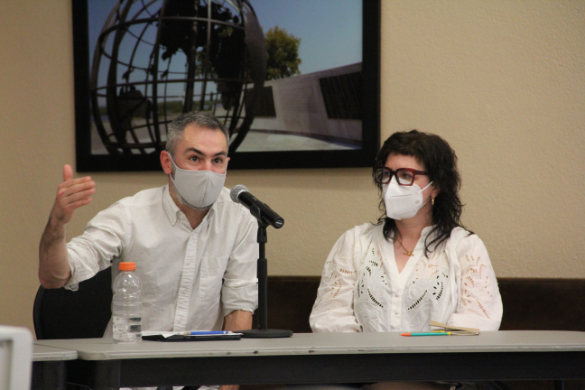Student Blog: Rethinking ‘Modern’ Architecture
We are continuing our series of student blogs with a number of reflections on the “Small Modernisms” symposium, a public event held at the Carleton Dominion-Chalmers Centre on May 12-13, 2022. The event was organized by Professors Michael Windover and Dustin Valen. The blogs were written by undergraduate students in the History and Theory of Architecture and Art History programs in Carleton’s School for Studies in Art and Culture.

By Ali Tocora Cuadros
In my first in-person class since the pandemic, Professor Michael Windover asked us to define the word modern. I immediately declared my distaste for all things modern. However, as I enter my fourth year in the History and Theory of Architecture program at Carleton, I now have a greater appreciation of the complexities surrounding this term. Similarly, after attending the “Small Modernisms” symposium I was struck by how the personal stories behind modernity can enrich our understanding of architecture and urban life in postwar Canada.
One important theme at the symposium was scale. Many presentations challenged the notion that modern architecture consists solely of enormous glass, steel, and concrete projects by eminent practitioners. Jan Hadlaw and Ben Bradley opened the symposium with an extraordinary presentation on family-built, -owned, and -operated roadside fruit stands in British Columbia’s southern interior. I had never considered fruit stands as architecture, despite having grown up in Niagara, a large farming region in southern Ontario, where fruit stands appear on almost every corner. They are vital pieces of the region’s modern economy. As Hadlaw and Bradley shared stories about families whose make-shift, roadside shacks were evidence of a thriving agricultural economy, I thought of my high school classmates, whose own family orchards and stately homes overshadowed the modest plywood stands where they sold fruit at the end of the drive. These modest structures speak to the complex web of scales that underlie modernity, stretching our understanding of the term.
Other presenters reminded us that modern architecture was not always an inclusive practice. Presentations by Oliver Vallerand and Jeffery Thorsteinson, as well as a walking tour with the Village Legacy Project, shed light on how women and members of the LGBTQ2s+ community experienced Canada’s postwar built environment differently. Thorsteinson’s presentation, “The Architecture of Decentralization: Big Dreams for Small Cities,” explored how the federal government encouraged women to enter the workforce by building offices in smaller cities as part of their effort to promote national unity and regional equality. Likewise, Vallerand’s paper, “Once Upon a Time: Unearthing Stories about Spaces used by LGBTQ People,” explored queer representation in Montreal’s red-light district by analysing Quebec-based film director Michel Tremblay’s Il était une fois dans l’est. The presentation caught my interest, having always appreciated the depiction of space in films. Vallerand spoke about the importance of film in studying undocumented and ephemeral spaces used by members of the queer community over time. Following these presentations, Glenn Crawford of the Village Legacy Project took us on a tour of sites important to the Ottawa LGBTQ2S+ community. Examples ranged from Parliament Hill and the Chateau Laurier to smaller bars and nightclubs connected to the queer community, as well as grassroots organizations, like Gays of Ottawa. The papers and tour offered new perspectives on many local buildings, whose history spoke to the challenges and violence suffered by members of the queer community, then and now.
The topics discussed at the “Small Modernisms” symposium offered me new perspectives on the concept of modernity. Attending an academic symposium was also a new experience for me. The immersive yet casual environment encouraged me chat with presenters who, in turn, expanded my understanding of modern architecture and the various paths for studying its complex meanings, without having to worry about grades. Once an intimidating subject, I now understand that the study of modern architecture is bursting with opportunities.